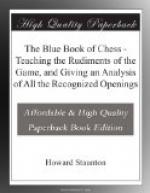1. e4 e5 2. Nf3 d6 3. d4 f5 4. dxe5 fxe4 5. Ng5 d5 6. f4 {This is not the proper move; he should play e6.} Bc5 7. c4 c6 8. Nc3 Ne7 9. h4 h6 10. Nh3 O-O 11. Na4 Bb4+ 12. Bd2 Bxd2+ 13. Qxd2 d4 14. c5 b5 15. cxb6 axb6 16. b3 Be6 17. Be2 Nf5 18. Ng1 Ng3 19. Rh2 e3 20. Qb2 d3 21. Bf3 Rxf4 22. O-O-O Rfxa4 23. bxa4 Rxa4 24. a3 Rc4+ 25. Kb1 Rc2 26. Qb4 Na6 27. Qf4 Nc5 28. Qxg3 {And Black mates in two moves.} — 0-1
{PGN 06}
[Event “Blindfold Exhibition”] [Site “Paris, FRA”] [Date “????.??.??”] [Round “?”] [White “Morphy”] [Black “Potier”] [Result “1-0”] [ECO “C42”] [Annotator “The Blue Book of Chess, Game I., p. 65.”] [PlyCount “49”]
1. {Mr. Morphy plays without seeing the Chess-board or men, against M. Potier, at Paris.} e4 e5 2. Nf3 Nf6 3. Bc4 Nxe4 4. Nc3 Nf6 {It is to be regretted that Mr. Potier did not take the Kt. rather than retreat, as many amateurs would have been pleased to see Mr. Morphy carrying out the attack of this interesting and comparatively novel debut.} 5. Nxe5 d5 6. Bb3 Be7 7. d4 c6 8. O-O Nbd7 9. f4 Nb6 10. Qf3 h5 11. f5 Qc7 12. Bf4 Bd6 13. Rae1 Kf8 14. Qg3 h4 15. Ng6+ {Finely played.} Kg8 16. Bxd6 hxg3 17. Bxc7 fxg6 18. fxg6 gxh2+ 19. Kh1 Bg4 20. Re7 Nbd7 21. Be5 Kf8 22. Rf7+ {The termination of this partie is remarkably elegant and finished.} Kg8 23. Nxd5 cxd5 24. Bxd5 Nb6 25. Bb3 1-0
{PGN 07}
[Event “?”] [Site “?”] [Date “1837.??.??”] [Round “?”] [White “Petroff”] [Black “3 Russian Amateurs”] [Result “0-1”] [ECO “C43”] [Annotator “The Blue Book of Chess, Game II., p. 66.”] [PlyCount “53”]
1. e4 e5 2. Nf3 Nf6 3. d4 Nxe4 4. Bd3 d5 5. Nxe5 Bd6 6. O-O O-O 7. c4 f5 8. f4 c6 9. Be3 Be6 10. cxd5 cxd5 11. Nc3 Nc6 12. Rc1 Rf6 {This unfortunate counter attack is admirably taken advantage of by M. Petroff.} 13. Bxe4 fxe4 14. Nb5 Ne7 15. Nxd6 Qxd6 16. g4 g6 {They do not appear to have had a better move.} 17. f5 {Well played.} gxf5 18. Bg5 Rff8 19. Bh6 Rfc8 {It would have been better to leave the Rook en prise, and advance f4.} 20. Qd2 Qd8 21. Rxc8 Rxc8 22. gxf5 Nxf5 23. Qg2+ Kh8 24. Rxf5 Qg8 25. Rf6 Bh3 26. Qg3 Qxg3+ 27. hxg3 0-1
{PGN 08}
[Event “?”] [Site “?”] [Date “????.??.??”] [Round “?”] [White “Tchigorin”] [Black “Pillsbury, H. N.”] [Result “0-1”] [ECO “C49”] [Annotator “The Blue Book of Chess, Game III., p. 67.”] [PlyCount “52”]
1. {Notes by Jas. Mason.} e4 e5 2. Nf3 Nf6 3. Nc3 Nc6 4. Bb5 Bb4 5. O-O O-O 6. d3 d6 7. Bg5 {In this familiar ‘double Lopez’ predicament, Bxc6 is highly recommended, if a dull but durable kind of game is desired.} Bxc3 8. bxc3 Ne7 {... Something like a leap in the dark. If the doubled Pawn can be ‘dissolved’ betimes, or the open file well used in attack, a safe landing may be confidently expected.} 9. Bxf6 gxf6 10. Qd2 Ng6 11. Kh1 {More or less necessary, sooner or later. Black does not attempt to dissolve, just here; for then Qh6, threatening Ng5, might be




